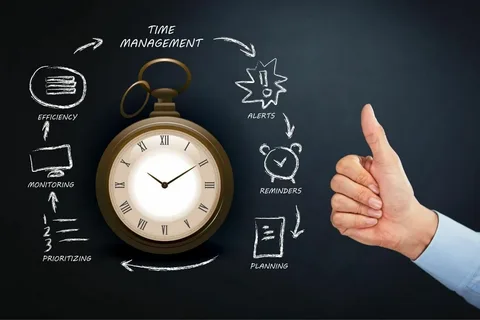Mastering Time Management: Strategies for Productivity and Balance
In today’s fast-paced world, time feels like a rare commodity. Between work deadlines, personal responsibilities, and the ever-increasing demands of modern life, managing time effectively can seem like an impossible task. Yet, time is the great equalizer—everyone has the same 24 hours in a day. The difference lies in how we use them.
In this comprehensive guide, we’ll explore the art and science of time management, breaking down proven techniques, tools, and habits that can help you reclaim your schedule and live a more productive, balanced life.
What is Time Management?
Time management is the process of planning and controlling how much time to spend on specific activities. It’s about prioritizing tasks, minimizing time-wasting activities, and increasing efficiency without burning out.
Effective time management allows you to:
Achieve more in less time
Reduce stress
Improve focus and clarity
Meet deadlines consistently
Have more free time for personal growth or leisure
Why is Time Management Important?
Let’s look at a few reasons why mastering time management is crucial:
1. Increased Productivity
When your time is organized, your tasks are more likely to get completed efficiently. You can shift focus from reacting to urgent matters to proactively working on important goals.
2. Less Stress and Anxiety
Scrambling at the last minute or missing deadlines can spike your stress levels. Managing your time properly reduces this tension, as you’ll have a clearer idea of what needs to be done and when.
3. Improved Work-Life Balance
With proper planning, you can allocate time for both professional and personal responsibilities, creating a healthy balance that prevents burnout.
4. Better Decision-Making
Time management encourages thoughtful planning, which leads to better choices. You’re less likely to act out of urgency or emotion when you have a roadmap in place.
Common Time Wasters to Avoid
Before diving into time management strategies, it’s important to recognize the common pitfalls that eat away at our time:
Procrastination: Delaying tasks for later leads to rushed, lower-quality work.
Multitasking: Trying to do multiple tasks at once reduces efficiency and accuracy.
Distractions: Social media, email notifications, and phone calls can fragment your focus.
Lack of Prioritization: Not knowing what to work on can lead to wasted energy on low-value tasks.
Poor Planning: Without a clear plan, your day can drift without direction.
Core Principles of Effective Time Management
1. Set Clear Goals
Start by identifying your short-term and long-term goals. Break them down into actionable tasks. Use the SMART framework (Specific, Measurable, Achievable, Relevant, Time-bound) to make your goals more effective.
2. Prioritize Tasks
Not all tasks carry equal weight. Use the Eisenhower Matrix to decide what’s urgent vs. important:
Important & Urgent: Do it immediately.
Important but Not Urgent: Schedule it.
Urgent but Not Important: Delegate it.
Not Urgent & Not Important: Eliminate it.
3. Plan Ahead
Begin each day or week with a plan. Identify key tasks, set goals for the day, and block time on your calendar to focus on priorities.
4. Use Time Blocks
The time blocking method involves dividing your day into sections for specific tasks. This minimizes multitasking and increases focus.
5. Limit Interruptions
Create boundaries during work hours. Turn off non-essential notifications, set “do not disturb” hours, and let others know when you are in focused work mode.
6. Delegate Wisely
You don’t have to do everything yourself. Delegation frees up time for high-value tasks and helps others grow in their roles.
Top Time Management Techniques
1. Pomodoro Technique
This method uses short bursts of focused work followed by short breaks. Work for 25 minutes, then rest for 5 minutes. After 4 cycles, take a longer break. It helps sustain concentration and avoid burnout.
2. Getting Things Done (GTD)
David Allen’s GTD method involves:
Capturing everything on your mind
Clarifying what actions are needed
Organizing tasks by context
Reflecting and reviewing regularly
Engaging and taking action based on priority
3. Eat That Frog
Popularized by Brian Tracy, this technique suggests doing the hardest or most important task (the “frog”) first thing in the day. It builds momentum and gives a sense of accomplishment early.
4. Time Tracking
Use tools like Toggl, Clockify, or RescueTime to track how you’re spending your time. This reveals hidden time-wasters and opportunities for improvement.
5. Batching Similar Tasks
Group similar tasks together to streamline your workflow. For example, answering emails for 30 minutes at one time instead of sporadically throughout the day improves efficiency.
Tools for Time Management
Here are some popular tools to help you stay organized:
| Tool | Purpose |
|---|---|
| Google Calendar | Scheduling & time blocking |
| Todoist | Task management |
| Notion | All-in-one workspace for notes, tasks, and goals |
| Trello | Visual project management |
| Evernote | Note-taking and organizing ideas |
| RescueTime | Time tracking and productivity insights |
Time Management for Different Roles
1. For Students
Use planners or digital calendars to track assignments and exam dates.
Study using Pomodoro sessions to improve retention.
Avoid cramming; break tasks into daily chunks.
2. For Professionals
Block time for deep work and meetings.
Avoid micromanagement by using project management tools.
Set email check times instead of responding constantly.
3. For Entrepreneurs
Outsource or automate repetitive tasks.
Keep a “big picture” view while focusing on daily execution.
Use OKRs (Objectives and Key Results) to align efforts with business goals.
4. For Parents
Create routines for mornings, homework, and bedtime.
Share responsibilities and delegate chores.
Schedule personal time to recharge.
How to Build Better Time Habits
Changing your relationship with time requires habit formation. Here’s how to create habits that stick:
Start Small: Begin with 1-2 time management techniques.
Be Consistent: Repeat daily until it becomes second nature.
Track Progress: Use journals or apps to monitor your development.
Reward Yourself: Celebrate milestones to reinforce the behavior.
Adjust as Needed: Your system should evolve as your responsibilities change.
Mindset Shifts for Time Management
Beyond techniques and tools, managing time effectively requires the right mindset.
Stop glorifying busyness: Being busy doesn’t mean you’re productive.
Accept that you can’t do everything: Focus on what truly matters.
Learn to say no: Protect your time by setting boundaries.
Embrace flexibility: Life is unpredictable—adapt as necessary.
Sample Daily Time Management Routine
Here’s a sample routine incorporating many of the tips discussed:
Morning (7:00 AM – 9:00 AM)
Wake up, stretch, or meditate
Review your daily goals
“Eat the frog” – tackle the most important task
Midday (9:00 AM – 12:00 PM)
Time-blocked work sessions
Pomodoro cycles (25 min work, 5 min break)
Minimal interruptions (notifications off)
Lunch & Break (12:00 PM – 1:00 PM)
Eat mindfully
Brief walk or relaxation
Afternoon (1:00 PM – 4:00 PM)
Meetings, collaborative work, or secondary tasks
Email responses in bulk
Wrap up with a mini review
Evening (4:00 PM – 8:00 PM)
Family time, personal errands
Light planning for tomorrow
Wind down without screens
Final Thoughts
Time is one of your most precious resources—and once it’s gone, it’s gone forever. Mastering time management isn’t just about getting more done; it’s about aligning your daily actions with your deeper values and goals. By using the techniques and tools shared in this guide, you can take control of your time and design a life that’s both productive and fulfilling.
Call to Action: Start Today
Choose one technique from this article and apply it today. Whether it’s blocking out your calendar or tackling your biggest task first, action is the first step toward better time management. Track your progress, stay flexible, and watch your productivity—and peace of mind—grow.



